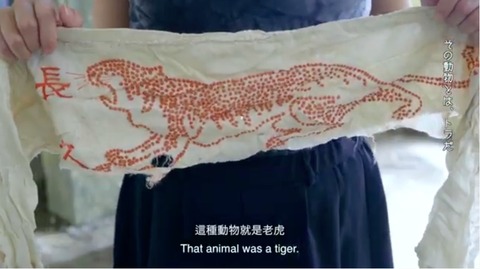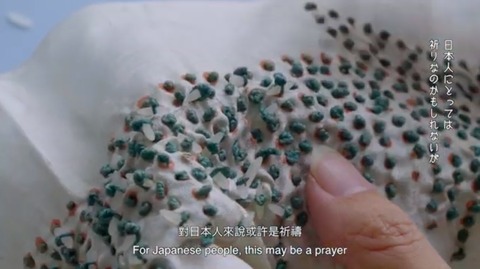

KYUN-CHOME
A Tiger Eaten by Pigeons
2018–2020 | Video installation | color | sound | 37’00”| | fabric
Back to the main page
The work of Kyun-Chome (Eri Homma and Nabuchi) concerns the fate of doves in Hong Kong; for example, those slaughtered during the time of SARS (although doves were not ‘guilty’ in terms of virus transmission). The artists give the doves the role of breaking the curse of the tiger. This stems from the tradition of Japanese women embroidering a tiger on the belts of Japanese soldiers, which represented their prayers for the soldiers’ safe return. Symbolically, the belt says that one thousand women (Sennin) prayed for their loved ones to remain safe and to kill as many enemies as possible (Sennin-Hari is the name for the belt).
The video is involving contemporary Hong Kong’s
ecological and environmental issues around doves, and
it includes the historical relationship between Hong
Kong and Japan during World War II. The video also
features the current political turbulence in Hong
Kong, with scenes shot by the artists while disguised
as journalists.
One of the artists, Nabuchi, got caught by the police and was about to be arrested during the shooting.
The artist couple, Eri and Nabuchi, established an artist unit, Kyun-chome in 2011. Their projects are research-based, and always develop narratives that could be a revelation, redemption, or salvation from the artist’s own perspectives. Kyun-Chome picks up the subject and context using their instinct and intuitively search for the facts. Their approach often reveals the different layers of events and is uniquely intriguing.
The couple artist won the Taro Okamoto Art Grand Prize in 2014 with a work about the Fukushima nuclear plants in Japan. Their work has been featured in the Aichi Triennale (2019), Bangkok Biennale (2018), the Dallas Contemporary (2017), the Reborn Festival Ishinomaki (2017), the National Modern Museum in Seoul (2017), and others.
Der Beitrag von Kyun-Chome (Eri Homma und
Nabuchi) befasst sich mit dem Schicksal der Tauben in
Hongkong, zum Beispiel derer, die während der SARS-
Epidemie getötet wurden (obwohl die Tauben nicht
‚schuld‘ an der Virusübertragung waren). Kyun-Chome
geben den Tauben die Rolle, den Fluch des Tigers zu
brechen. Hintergrund ist ein japanischer Brauch:
Frauen stickten einen Tiger auf den Gürtel von Solda-
ten, als Symbol ihrer Wünsche nach sicherer Heimkehr
der Soldaten. Dieser Tradition zufolge beteten tausend
Frauen (Sennin), dass ihre Geliebten unversehrt blei-
ben und so viele Feinde wie möglich töten sollten
(Sennin-Hari).
In das Video fließen ökologische Fragen und Umwelt-
probleme im Zusammenhang mit Tauben im heutigen
Hongkong ebenso ein wie das historische Verhältnis
von Hongkong und Japan im 2. Weltkrieg. Auch die
aktuellen politischen Turbulenzen in Hongkong wer-
den gezeigt; beim Drehen gaben sich Kyun-Chome als
Journalist*innen aus.
Einer der beiden, Nabuchi, wurde während der Dreharbeiten von der Polizei mitgenommen und beinahe inhaftiert.
2014 gewann das Duo mit einer Arbeit über die Fukushima-Kernkraftwerke in Japan den Taro Okamoto Art Grand Prize. Sie waren unter anderem bei der Aichi Triennale (2019) und der Bangkok Biennale (2018), im Dallas Contemporary (2017), beim Reborn Festival Ishinomaki (2017) und im National Modern Museum in Seoul vertreten.
コメント